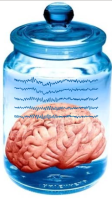S. Romero, 2010
Reduction of artifacts in EEG signals by using new techniques of automatic filtering based on blind separation of sources
By Sergio Romero
Directed by Miguel Ángel Mañanas and Manel Josep Barbanoj
2010.06.21Summary

Quantitative analysis and interpretation of electroencefalographic (EEG) signals are useful methods to study functional states of the brain, to evaluate drug effects and to diagnose psychiatric and neurological disorders. However, it is known that non-cortical interferences contribute to EEG recordings. Ocular artifacts are the most relevant and critical interference. The gold standard method in neuropsychopharmacology for reducing ocular contamination is based on linear regression. Nevertheless, this technique not only reduces the ocular contamination, but also cancels relevant cerebral information contained in the electrooculographic (EOG) recordings. In this way, the development of new automatic methods for reducing ocular artifacts in EEG signals, that solve the drawbacks shown by most common used techniques, is a crucial step in the clinical trials that assess the effects of a drug in the central nervous system. The aim of this PhD thesis is the design and the objective evaluation of automatic ocular filtering methods in spontaneous EEG signals in order to quantitatively improve the results and conclusions obtained in pharmaco-EEG studies. The most relevant contributions of this thesis are: 1) The implementation of a new completely automatic method for reducing ocular contamination in EEG signals. This procedure is based on the BSS algorithms, AMUSE or SOBI indistinctly, it is applied in short duration segments, and it includes the automatic detection of the source components related to ocular activity. 2) The estimation of MISO models corresponding to the propagation of ocular and cerebral activities across the scalp. These models have contributed with interesting information about the discussion if ocular propagation is frequency dependent or independent. These results conclude that ocular and cerebral propagation can be considered practically frequency independent which is consistent to what would be expected from the biophysics knowledge. 3) The development of a computer tool for EEG signals processing in pharmaco-EEG studies. The Drug Research Center (CIM) of the Hospital de la Santa Creu i Sant Pau of Barcelona has started to use this interactive graphical user interface for evaluating the effect of a drug on the brain in several pharmaco-EEG studies.
TDX Link
Share: